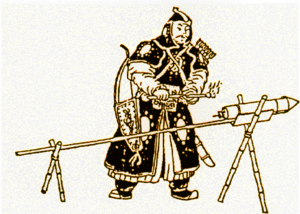863 Program
The 863 program (Chinese: 863计划) or State High-Tech Development Plan (Chinese: 国家高技术研究发展计划) is a program funded and administered by the government of the People's Republic of China intended to stimulate the development of advanced technologies in a wide range of fields for the purpose of rendering China independent of financial obligations for foreign technologies.[1]
Among the products known to have resulted from the 863 program are the Loongson computer processor family (originally named Godson), the Tianhe supercomputers and the Shenzhou spacecraft.
History
 |
| History of science and technology in China |
|---|
| By subject |
| By era |
Named after its date of establishment (March 1986, 86/3 by the Chinese date format), the 863 Program was proposed in a letter to the Chinese government by engineers Wang Ganchang, Wang Daheng, Yang Jiaxi, and Chen Fangyun and endorsed by Deng Xiaoping.[2] After its implementation during the Seventh Five-Year Plan, the program continued to operate through the two five-year plans that followed, with state financing of around 11 billion RMB and an output of around 2000 patents (national and international).[3]
Under the plan, about US $200 billion was to be spent on information and communication technologies, of which US $150 billion was earmarked for telecommunications. In 1996 the key technological field of Marine Technology was added. The implementation took place during the Seventh Five-Year Plan and an update has been made during the period of the Tenth, which lasted from 2001 to 2005.
In 2001, under the Tenth Five-Year Plan, the program was reevaluated in consultation with foreign experts. The result was a widened focus to strengthen the competitiveness of China in the global economy.[4] The evaluation practice has been included into the program as a project management system.[5]
In a 2011 court case, Chinese-born scientist Huang Kexue was found guilty of stealing commercial secrets from US-based corporations and passing at least some of this information to the 863 program.[6]
Outline
The program initially focused on seven key technological fields:[7]
Since 1986, two more fields have been brought under the umbrella of the program:
- Telecommunications (1992)
- Marine technology (1996)
See also
References
- ↑ Wu, Hequan (2002-08-06), "The progress of communication technology subject of hi-tech research development plan of China", International Conference on Communication Technology Proceedings, 2000, Beijing, 1: 3–4, doi:10.1109/ICCT.2000.889157, ISBN 0-7803-6394-9
- ↑ Feigenbaum, Evan A. (2003), China's Techno-warriors: National Security and Strategic Competition from the Nuclear to the Information Age, Stanford, California: Stanford University Press, p. 141, ISBN 978-0-8047-4601-4, OCLC 49415750
- ↑ Science & Technology Newsletter No.380: 863 Program Creates RMB 56 Billion Ministry of Science & Technology of the People's Republic of China (MOST) September, 30th 2004
- ↑ "National High-tech R&D Program (863 Program)". Ministry of Science and Technology of the People's Republic of China. Retrieved 1 April 2015.: 1. Orientation and Objectives, 2. Major Tasks.
- ↑ "National High-tech R&D Program (863 Program)". Ministry of Science and Technology of the People's Republic of China. Retrieved 1 April 2015.: 4. Organization and Management, 2) Project Management.
- ↑ BBC News Chinese scientist Huang Kexue jailed for trade theft December, 22nd 2011
- ↑ Ke Yan (Ke, Yan), Science and Technology in China, German Edition (Beijing 2005), p.109 Passages readable online